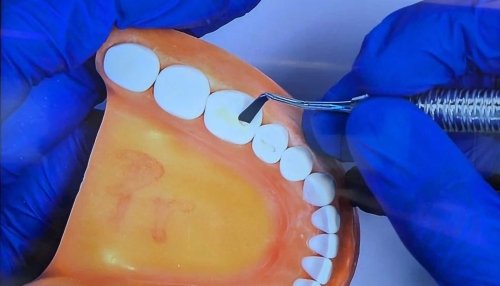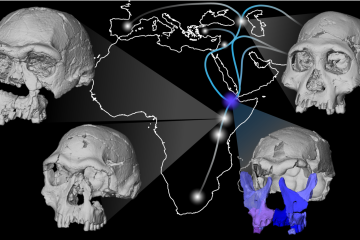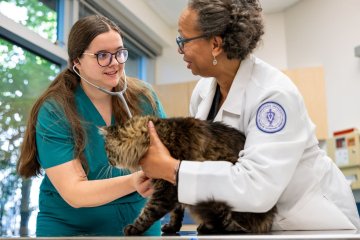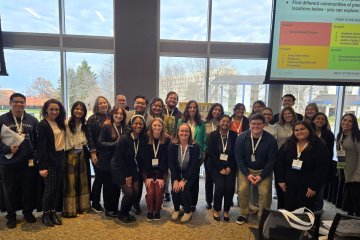CDMI and CHS collaborate on Hand Joint Hypermobility Study
Interdepartmental collaboration examines hypermobility for incoming dental students
- IL - Downers Grove

Intervention assists dental students with hypermobility adjust to proper positioning.
Midwestern University faculty and students from the College of Dental Medicine – Illinois (CDMI) and the Occupational Therapy Program in the College of Health Sciences (CHS) in Downers Grove joined forces in an ongoing research project to investigate hypermobility among first-year dental students. Both Colleges brought their specialized skill sets to this project.
“The greatest thing is everyone contributed with their expertise,” said Linda Sangalli D.D.S., M.S., Ph.D., Assistant Professor, CDMI, “Research can gather people together and strengthen the collaboration with the departments. We have our specialties. When we collaborate, we can accomplish more.” Occupational Therapy faculty who are Certified Hand Therapists paired with Occupational Therapy students to perform hand assessments on incoming first-year dental students as part of their orientation. The dental students were assessed for hyperextension and grip and pinch strength were measured. The Occupational Therapists then determined whether students’ joints had no hypermobility, or if they showed low, medium, or high degrees of hypermobility. Based on the assessment, strategies were recommended for students, such as small splits to provide stability to joints or strengthening exercises if their hand muscles were weaker.
Dana Lingle, O.T.D., OTR/L, CHT, Assistant Professor, Occupational Therapy, added, “Hypermobility doesn’t mean students can’t perform to their ability. Hypermobile joints need adaptation to do dental work.” One of the adaptation options for students is to wear a splint on a finger under the gloves, Dr. Lingle said.
Melisa Alabsy, D.D.S., M.H.A., Director of Preclinical Curriculum, CDMI, said, “Some (dental) students have difficulty adjusting to grabbing the handpiece. They learned to adapt and reposition in ways where they were not straining the joints.” The students should grasp the handpiece from three places of support. For students diagnosed with hypermobility, targeted exercises were provided to complete at home. “Hypermobility was present in more than 30 percent in a class of 140. However, that doesn’t mean 30 percent will have problems. It is something that the students and faculty should be aware of. There are ways to help. If we already know it is a condition that is prevalent, then we can intervene sooner.” She added students are young and strong and may not know there is an issue. The screening process helps create awareness and fosters a positive environment where students feel supported throughout their academic journey. Future studies will identify if hypermobility is progressive and if there is an onset of pain during dental school.
Interdepartmental projects support professional education at Midwestern University and offer benefits to students and faculty. Dr. Sangalli said, “This experience strengthened the curriculum we offer and emphasized the importance of collaboration. The community as a whole and the scientific community saw we’re active in research.” Dr. Alabsy added, “We’re hoping to present some of these findings at American Association for Dental, Oral, and Craniofacial Research (AADOCR) next year. The impact transcends beyond our school.” Dr. Lingle said regarding interprofessional projects, “We’re solution finders. I like that I’m involved in something outside of Occupational Therapy and that I am able to show Occupational Therapy’s value in a different field. I love that this is an interprofessional endeavor.” Dr. Lingle added sometimes dentists leave the workforce early due to pain, and correcting the hand positioning can lead to a longer quality of life without pain.
Dr. Alabsy also said, “As healthcare professionals, we want to improve health outcomes for patients. One of the things I like about Midwestern University is the culture and expectation of being under one umbrella. The One Health concept is something unique to Midwestern University and the benefits for the students are real and tangible.”
Midwestern University offers students opportunities to participate in research projects that will enhance their careers as future healthcare providers or give them the experience to become scientific researchers. The academic programs at Midwestern University include dental medicine in Downers Grove (CDMI) and Glendale (CDMA) and occupational therapy in Downers Grove (CHS) and Glendale (CHS).



